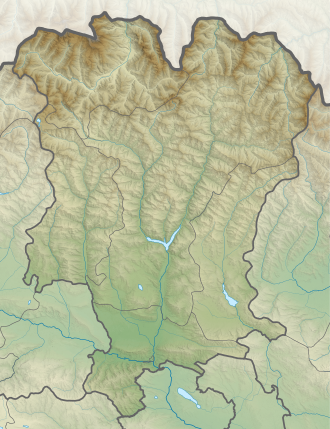Darial Gorge
| Darial Gorge ( valley pass ) |
|||
|---|---|---|---|
|
The Darial Gorge: View from south to north (down the valley) |
|||
| Compass direction | north | south | |
| height | 1204 m | ||
| region | Republic of North Ossetia-Alania ( Russia ) | Region Mtskheta-Mtianeti ( Georgia ) | |
| Waters | Terek | ||
| expansion | Georgian Military Road | ||
| Built | 1799 | ||
| Mountains | Greater Caucasus | ||
| Map (Mtskheta-Mtianeti) | |||
|
|
|||
| Coordinates | 42 ° 44 ′ 41 ″ N , 44 ° 37 ′ 21 ″ E | ||
The Darial Gorge or Dariel Gorge ( Georgian დარიალის ხეობა , Darialis Keoba ; Russian Дарьяльское ущелье ) is an eleven kilometer long gorge in northern Georgia on the border with Russia .
location
It is located at the eastern foot of Mount Kazbek at 1204 m in the Greater Caucasus and is traversed by the Terek River. The almost 600 meters towering steep rock walls on both sides of the gorge come together at a distance of eight meters. The eye of the needle on the way across the Caucasus was of great strategic importance for centuries.
Surname
The current name is borrowed from the neo-Persian name of the pass dar-i Alan (English: gate of the Alans ). In Georgian historiography he is called Ralani , Dargani or Darialani . For the Roman scientist and geographer Pliny it was the Portae Caucasiae or Portae Hiberiae . With Ptolemy the pass was called Sarmatikai Pylai ( Greek Σαρματικαι Πυλαι ). The Tatars called him Darioli .
history
The control of the eye of the needle on the only route across the Caucasus for centuries played an important role in the foreign policy of Georgia, the Roman Empire , Persia , the Arab caliphates , Byzantium and later Russia . Up until the 13th century , the main aim was to prevent bellicose nomadic tribes from the North Caucasus, including the Alans from which it was named, from advancing south. They had invaded Georgia, Azerbaijan and Armenia regularly . From the 18th century , the pass for the connection between Russia and Georgia gained increasing economic and military importance. In 1799 the traffic route above the pass was cut into the rock.
After the conquest of Iberia by Pompey in 66 BC. The Romans built the Kumania fortress in the gorge and a wall made of logs that was reinforced with iron. The Iberian kings operated the fortress under the name Kumli for several centuries. It was renovated several times. Its ruins on a mountain on the left bank of the Terek can still be seen today. It had watchtowers and a secret passage to the river. Persia built the Biriparach fort in the 5th century , in which around 1000 soldiers were stationed. After 1801 Russia built the fortress Darialskoje (Russian Дарьяльское) at the northern exit of the gorge , the sparse remains of which are now just beyond the Russian-Georgian border on Georgian territory. The Soviet Union also used the natural bottleneck. She controlled travel through a military post with a barrier . Between 2006 and 2010 the border between Georgia and Russia in the Dariel Gorge was closed.
Transport infrastructure
The main road S3 , which forms a section of the historic Georgian Military Road , runs from the Georgian side to the border crossing with Russia . On the Russian side, the trunk road leading in the direction of Vladikavkaz is designated A161 (previously A301).
"Darial Gorge" by R. Sudkowskyj 1884, Russian Museum
Web links
- Article Darialschlucht in the Great Soviet Encyclopedia (BSE) , 3rd edition 1969–1978 (Russian)
- Agustí Alemany: Alania in the 6th century: Between Byzantium, Sassanid Iran and the Turkish world , 2003 (English, PDF file; 110 kB)
Individual evidence
- ↑ Website of the Mzcheta-Mtianeti region: History Kazbegi District ( page no longer available , search in web archives ) Info: The link was automatically marked as defective. Please check the link according to the instructions and then remove this notice.
- ↑ Giorgi Leon Kavtaradze: The Georgian Chronicles And the Raison D'Ètre of the Iberian Kingdom ( Memento of the original from June 11, 2012 in the Internet Archive ) Info: The archive link was inserted automatically and has not yet been checked. Please check the original and archive link according to the instructions and then remove this notice. . In: International Journal of Historical Geography of the Old World, 6/2000





